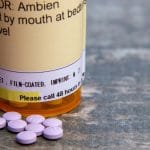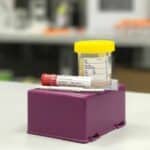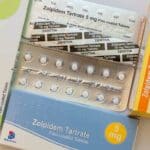Ambien and Ambien CR (the brand names for zolpidem/zolpidem tartrate) are considered sedative-hypnotics and Schedule IV controlled substances.
While the drug has a low potential for abuse, it can be addictive, lead to negative side effects, and be very difficult to stop use.
Ambien Classification
Ambien belongs to the non-benzodiazepine sedative-hypnotic drug class. This means it works by activating the neurotransmitter GABA, which in turn slows down the central nervous system (CNS).
This is what allows the body to be better prepared for sleep and why the drug is often used to treat sleep disorders like insomnia.
The drug also increases the amount of dopamine in the brain that can lead to a euphoric feeling. This euphoric feeling is one of the reasons why the drug is abused.
And when the drug is abused, the sedative qualities can lead to serious adverse effects like slowed heart rate and slowed breathing.
Ambien Drug Schedule
The FDA classifies Ambien as a Schedule IV controlled substance. This classification means that the drug has a lower potential for abuse than other drugs, but that it can still be habit-forming and lead to dependence and addiction.
If you abuse the prescription drug or take it in higher doses than recommended, you may begin craving it. Your body can also become so dependent on it that it no longer functions properly without it. This can make it very difficult to quit once you begin abusing Ambien.
Other medications in this schedule include lorazepam (Ativan) and alprazolam (Xanax).
Side Effects Of Ambien Abuse
Ambien use comes with a long list of side effects whether you abuse it or not. But if you are struggling with a substance use disorder related to Ambien, these side effects can become even more intense.
Side effects include:
- next-day drowsiness or impairment
- headache
- dizziness
- nausea
- constipation
- diarrhea
- heartburn
- changes in appetite
- tremors
- muscle aches
Drug Interactions & Polydrug Abuse
While Ambien is abused on its own, people also may abuse it with other drugs. Unfortunately, some of the drugs that you might abuse with Ambien may be a drug that negatively interacts with it and leads to adverse reactions.
If you abuse other drugs with Ambien, the side effects can be even more dangerous than if you abuse them on their own.
Dangerous drug interactions can occur if you combine Ambien with:
- antihistamines
- antidepressants
- anticonvulsants
- ketoconazole
- muscle relaxants
- opioids
- selective serotonin reuptake inhibitors (SSRIs)
- sleep aids
- valproic acid
Ambien Overdose
Abusing Ambien can also lead to an increased risk of an overdose which can bring on severe symptoms and, if left untreated, can be life-threatening.
If you or a loved one experience signs or symptoms of an overdose, you need to call 911 immediately.
Overdose symptoms include:
- severe drowsiness
- lightheadedness
- confusion
- memory loss
- impaired ability to drive, think and work at a normal level
- hallucinations
- respiratory depression
- slowed heart rate
Withdrawal Symptoms
Along with the potential risks of an overdose, physical dependence is another issue when someone abuses Ambien or drugs like it. If you continually abuse the drug, you’re likely to build up a dependence. Then, if you try to stop using, withdrawal symptoms are likely to occur.
Some of the withdrawal symptoms you may experience after discontinuation include:
- agitation
- high blood pressure
- fever
- stomach cramps
- insomnia
- convulsions
- nausea
- vomiting
- panic attacks
These symptoms can make it difficult to stop taking Ambien. Luckily, there are lots of treatment options available to help you quit the drug entirely.
Treatment For Ambien Abuse
There are multiple types of treatment for those struggling with Ambien abuse and addiction including detox, inpatient treatment, and outpatient care.
Detox
During the medical detox process, a healthcare provider may create a taper-down schedule so that you can withdraw slowly from the drug and not have to deal with as many withdrawal symptoms. It makes the process a lot more comfortable.
Once you’re stable, you can move on to inpatient or outpatient rehab.
Inpatient Rehab Programs
Inpatient rehabilitation requires you to stay at a residential facility 24/7 and follow a strict routine that includes therapy, support groups, education on addiction, relapse prevention, and other activities. With Ambien addiction, rehab may also include establishing good sleeping habits as well.
If you have co-occurring disorders like depression or anxiety, you can seek treatment for those along with the substance use disorder. These rehab programs usually last between 30 and 90 days.
Outpatient Rehab Programs
Outpatient rehabilitation offers similar treatment as inpatient care, but instead of staying at a residential facility, you can go home after treatment each day. During outpatient treatment, you’ll likely go to therapy and group meetings.
Get Help Today
If you or a loved one is struggling with an Ambien addiction, please call our helpline today for information on our outpatient services.
Sources
Written by
Northeast Addition Editorial Team
©2024 Northeast Addition Center | All Rights Reserved
This page does not provide medical advice.




